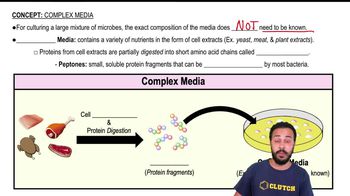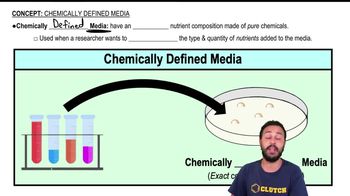By deep-freezing, bacteria can be stored without harm for extended periods. Why do refrigeration and freezing preserve foods?
Differentiate complex and chemically defined media.
 Verified step by step guidance
Verified step by step guidance
Verified Solution
Key Concepts
Complex Media

Chemically Defined Media

Applications in Microbiology

Nitrogen and phosphorus added to beaches following an oil spill encourage the growth of natural oil-degrading bacteria. Explain why the bacteria do not grow if nitrogen and phosphorus are not added.
Which one of the following temperatures would most likely kill a mesophile?
a. -50℃
b. 0℃
c. 9℃
d. 37℃
e. 60℃
Which of the following is true about the optimum growth temperature of most mesophiles?
a) They can grow well at 37^0C.
b) They are more likely to grow at refrigerator temperatures.
c) They can strive well in extremely high temperatures.
d) All of the above.
Which of the following types of media would not be used to culture aerobes?
a. selective media
b. reducing media
c. enrichment media
d. differential media
e. complex media
The thermal death time for a suspension of Bacillus subtilis endospores is in dry heat and less than in an autoclave. Which type of heat is more effective? Why?
